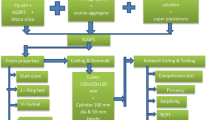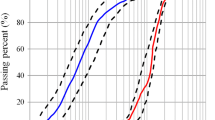Abstract
The application of conventional soundless (or silent) chemical demolition agents (SCDAs) is complicated and it is easy for the agents to extrude from boreholes; it is also difficult to use it in wet or up-tilt boreholes, which limits their engineering application. In this paper, the components of conventional SCDAs are optimized and an innovative SCDA cartridge is presented, which is called self-swelling cartridge (SSC). Water absorption, expansion pressure and mechanical property tests of the novel SSC after hydration reaction were carried out to investigate the expansibility and the mechanical properties of the new SSC. The test results indicate that the water absorption rate and the water absorption at full saturation decrease with the increase of the agent packing density. The recommended agent packing density is 1.65 g/cm3, at which the immersion time and the water absorption for full saturation are 9 min and 22%, respectively. The expansion pressure of the SSC is influenced by roll diameter, agent packing density, and insertion gap. The expansion pressure is most sensitive to the insertion gap and least sensitive to the cartridge diameter. An empirical formula relating the expansion pressure and its influencing factors is presented. Both the uniaxial compressive strength and the elastic modulus of the SSC after hydration reaction increase with the increase of reaction time, while the Poisson’s ratio decreases with the increase of reaction time. With the increase of confining pressure, the peak strength increases linearly, which can be described by the Mohr–Coulomb strength criterion. The novel SSC is easy to be used and the SCDA paste is less likely to be extruded from boreholes. It can be applied to fracturing rock masses using boreholes in any inclination, dry or wet. This is important for broadening the application of SCDA.












Similar content being viewed by others
References
Fairhurst C, Hudson J (1999) Draft ISRM suggested method for the complete stress-strain curve for intact rock in uniaxial compression. Int J Rock Mech Min Sci 36:279–289
Arshadnejad S, Goshtasbi K, Aghazadeh J (2011) A model to determine hole spacing in the rock fracture process by non-explosive expansion material. Int J Miner Metall Mater Struct 18:509–514
Ba H, Liu Q (1988) Research on several problems of static blasting agent. J Wuhan Univ Technol 2:61–68
Barenblatt GI (1987) Dimensional analysis. CRC Press, Boca Raton
Bowers B, Schatzman L (2009) Dimensional analysis in developing grounded theory: the second generation. Left Coast Press, California
Chatterji S (1995) Mechanism of expansion of concrete due to the presence of dead-burnt CaO and MgO. Cem Concr Res 25:51–56
Chatterji S, Jeffery J (1966) The volume expansion of hardened cement paste due to the presence of “dead-burnt” CaO. Mag Concr Res 18:65–68
China NDaRCo (2008) Soundless cracking agent. Building Materials Industry Press, Beijing
Dai X (2016) Development of loading system using static cracking agent for blasting failure law of brittle material in high stress. Doctoral dissertation, Northeastern University
De Silva RV, Pathegama Gamage R, Perera A, Samintha M (2016) An alternative to conventional rock fragmentation methods using SCDA: a review. Energies 9:958–989
De Silva VRS, Ranjith PG, Perera MSA, Wu B, Rathnaweera TD (2017) Investigation of the mechanical, microstructural and mineralogical morphology of soundless cracking demolition agents during the hydration process. Mater Charact 130:9–24
De Silva V, Ranjith P, Perera M, Wu BJJoNGS, (2019) The effect of saturation conditions on fracture performance of different soundless cracking demolition agents (SCDAs) in geological reservoir rock formations. J Nat Gas Sci Eng Geol 62:157–170
Deighton M (1976) Fracture of brittle solids. Phys Bull 27:220–221
Egbert J, Staples S (2019) Doing multi-dimensional analysis in SPSS, SAS, and R. In: Sardinha TB, Pinto MV (eds) Multi-dimensional analysis : research methods and current issues, 1st edn. Bloomsbury Academic, London, pp 125–144
Étkin M, Azarkovich A (2006) Effect of non-explosive splitting compounds and rational work parameters. Power Technol Eng 40:287–292
Gambatese JA (2003) Controlled concrete demolition using expansive cracking agents. J Constr Eng Manag 129:98–104
Guo T, Zhang S, Ge H, Qu Z (2015) A **novel" soundless cracking agent fracturing" for shale gas reservoir stimulation. Int J Environ Sci Dev 6:681–687
Guo T, Zhang S, Ge H, Wang X, Lei X, Xiao B (2015) A new method for evaluation of fracture network formation capacity of rock. Fuel 140:778–787
Harada T, Idemitsu T, Watanabe A, Takayama S-I (1989) The design method for the demolition of concrete with expansive demolition agents. In: Shah SP, Swartz SE (eds) Fracture of concrete and rock. Springer, New York, pp 47–57
Harada T, Soeda K, Idemitsu T, Watanabe A (1993) Characteristics of expansive pressure of an expansive demolition agent and the development of new pressure transducers. Doboku Gakkai Ronbunshu 1993:91–100
He Q, Suorineni F, Oh J (2016) Review of hydraulic fracturing for preconditioning in cave mining. Rock Mech Rock Eng 49:4893–4910
He Q, Suorineni F, Oh JJRM (2017) Strategies for creating prescribed hydraulic fractures in cave mining. Rock Mech Rock Eng 50:967–993
He Q, Suorineni FT, Ma T, Oh J (2018) Parametric study and dimensional analysis on prescribed hydraulic fractures in cave mining. Tunn Undergr Space Technol 78:47–63
Hertzberg RW, Saunders H (1985) Deformation and fracture mechanics of engineering materials (2nd edition). J Press Vessel Technol Trans ASME 107:309–311
Huynh M-P, Laefer DF (2009) Expansive cements and soundless chemical demolition agents: state of technology review. In: The 11th conference on science and technology, Ho Chi Minh City Vietnam, October 21–23, 2009
Kasai Y (1989) The Second International RILEM Symposium on demolition and reuse of concrete and masonry. Mater Struct 22:312–319
Kasama T, Saito T, Wada M (1983) Hydration-expansive crushing cartridge. U.S. Patent
Kim K, Cho H, Sohn D, Koo J, Lee J (2018) Prediction of the minimum required pressure of soundless chemical demolition agents for plain concrete demolition. J Comput Struct Eng Inst Korea 31:251–258
Kovari K, Tisa A, Einstein HH, Franklin JAJIJoRM (1983) Suggested methods for determining the strength of rock materials in triaxial compression: revised version. Int J Rock Mech Min Sci Geomech Abstr 20:283–290
Laefer DF, Ambrozevitch-Cooper N, Huynh M, Midgette J, Ceribasi S, Wortman J (2010) Expansive fracture agent behaviour for concrete cracking. Mag Concr Res 62:443–452
Lawn B (1993) Fracture of brittle solids. Cambridge University Press, Cambridge
Li Y, Li K, Feng X, Cai M (2018) Development and evaluation of artificial expandable pillars for hard rock mining. Int J Rock Mech Min Sci 110:68–75
National Development and Reform Commission PsRoC (2008) Soundless cracking agent vol JC 506-2008. Building Materials Industry Press, Beijing
Norušis MJ (2011) IBM SPSS statistics 19 guide to data analysis. Prentice Hall Upper Saddle River, New Jersey
Pawlik PS, Reisman H (1980) Elasticity: theory and applications. Wiley, New York
Peng J, Zhang F, Yan G, Qiu Z, Dai X (2019) Experimental study on rock-like materials fragmentation by electric explosion method under high stress condition. Powder Technol 356:750–758
Ramachandran VS, Sereda PJ, Feldman R (1964) Mechanism of hydration of calcium oxide. Nature 201:288–289
Shang J, Zhao Z, Aliyu M (2018) Stresses induced by a demolition agent in non-explosive rock fracturing. Int J Rock Mech Min Sci 107:172–180
Swanson D, Labuz J (1999) Behavior of a calcium oxide-based expansive cement. Concr Sci Eng 1:166–172
Szirtes T (2007) Applied dimensional analysis and modeling. Butterworth-Heinemann, Oxford
Xie B, Yan Z, Zhao Z (2018) Experimental study on anti-spraying hole of static blasting based on physical cooling. J Saf Sci Technol 14:150–154
Xu QJ, Jiang N, Long Y, Liao Y, Yang T, Ji R, Liu D (2015) Investigation of the large scale borehole soundless cracking experiment on the concrete members. In: Applied mechanics and materials, 2015. Trans Tech Publ, pp 219–226
Xu S, Hou P, Cai M, Li Y (2019) An experiment study on a novel self-swelling anchorage bolt. Rock Mech Rock Eng 52:4855–4862
You B (2008) Static blasting technology: soundless chemical agent and its application. China Building Materials Press, Beijing
Zhai C, Xu J, Liu S, Qin L (2018) Fracturing mechanism of coal-like rock specimens under the effect of non-explosive expansion. Int J Rock Mech Min Sci 103:145–154
Zhang F, Yan G, Peng J, Qiu Z, Dai X (2019) Experimental study on crack formation in sandstone during crater blasting under high geological stress. Bull Eng Geol Environ 79:1323–1332
Acknowledgements
This study was funded by the State Key Research Development Program of China (2018YFC0604400), the National Science Foundation of China (51874068, 51974061), the Fundamental Research Funds for the Central Universities (N160107001, N180701016, N2001003), and the 111 Project (B17009).
Author information
Authors and Affiliations
Corresponding authors
Ethics declarations
Conflict of interest
The authors declare that they have no conflict of interests.
Additional information
Publisher's Note
Springer Nature remains neutral with regard to jurisdictional claims in published maps and institutional affiliations.
Rights and permissions
About this article
Cite this article
Xu, S., Hou, P., Li, R. et al. An Experimental Study on the Mechanical Properties and Expansion Characteristics of a Novel Self-Swelling Cartridge for Rock Breakage. Rock Mech Rock Eng 54, 819–832 (2021). https://doi.org/10.1007/s00603-020-02305-x
Received:
Accepted:
Published:
Issue Date:
DOI: https://doi.org/10.1007/s00603-020-02305-x




